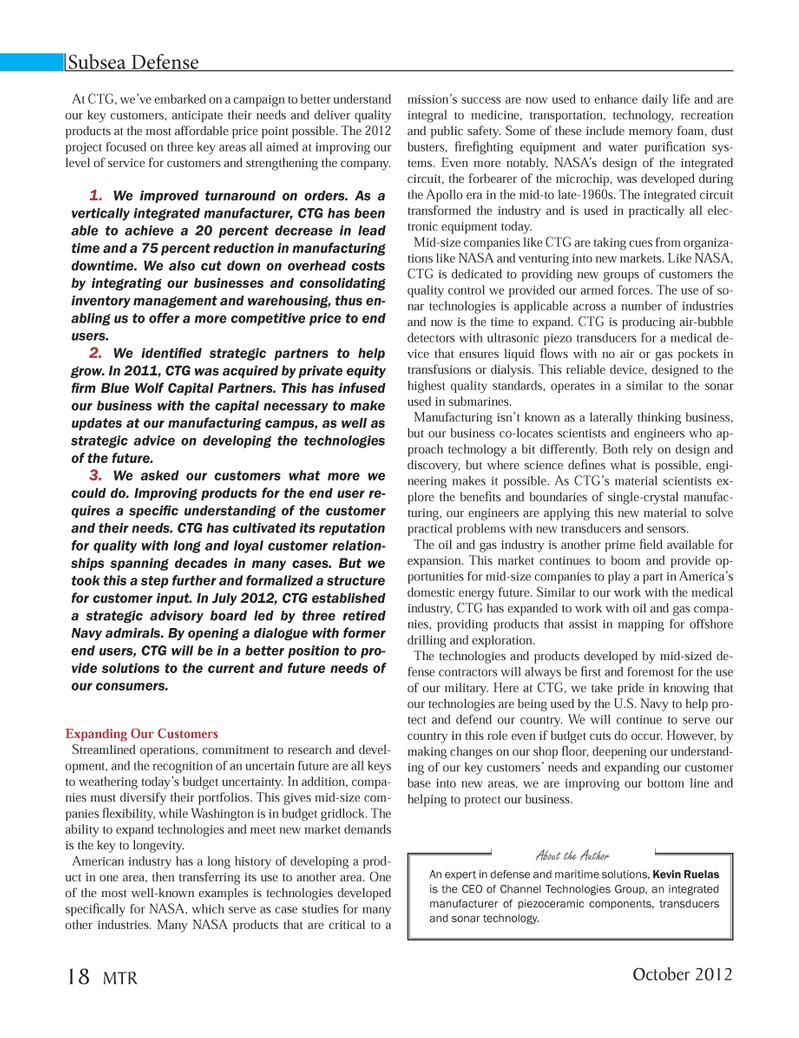
Page 18: of Marine Technology Magazine (October 2012)
Ocean Observation: Gliders, buoys & sub surface monitoring networks
Read this page in Pdf, Flash or Html5 edition of October 2012 Marine Technology Magazine
At CTG, we?ve embarked on a campaign to better understand our key customers, anticipate their needs and deliver quality products at the most affordable price point possible. The 2012 project focused on three key areas all aimed at improving our level of service for customers and strengthening the company. 1. We improved turnaround on orders. As a vertically integrated manufacturer, CTG has been able to achieve a 20 percent decrease in lead time and a 75 percent reduction in manufacturing downtime. We also cut down on overhead costs by integrating our businesses and consolidating inventory management and warehousing, thus en- abling us to offer a more competitive price to end users. 2. We identi Þ ed strategic partners to help grow. In 2011, CTG was acquired by private equity Þ rm Blue Wolf Capital Partners. This has infused our business with the capital necessary to make updates at our manufacturing campus, as well as strategic advice on developing the technologies of the future.3. We asked our customers what more we could do. Improving products for the end user re- quires a speciÞ c understanding of the customer and their needs. CTG has cultivated its reputation for quality with long and loyal customer relation- ships spanning decades in many cases. But we took this a step further and formalized a structure for customer input. In July 2012, CTG established a strategic advisory board led by three retired Navy admirals. By opening a dialogue with former end users, CTG will be in a better position to pro- vide solutions to the current and future needs of our consumers. Expanding Our CustomersStreamlined operations, commitment to research and devel- opment, and the recognition of an uncertain future are all keys to weathering today?s budget uncertainty. In addition, compa- nies must diversify their portfolios. This gives mid-size com- panies exibility, while Washington is in budget gridlock. The ability to expand technologies and meet new market demands is the key to longevity. American industry has a long history of developing a prod- uct in one area, then transferring its use to another area. One of the most well-known examples is technologies developed speci cally for NASA, which serve as case studies for many other industries. Many NASA products that are critical to a mission?s success are now used to enhance daily life and are integral to medicine, transportation, technology, recreation and public safety. Some of these include memory foam, dust busters, re ghting equipment and water puri cation sys- tems. Even more notably, NASA?s design of the integrated circuit, the forbearer of the microchip, was developed during the Apollo era in the mid-to late-1960s. The integrated circuit transformed the industry and is used in practically all elec-tronic equipment today. Mid-size companies like CTG are taking cues from organiza- tions like NASA and venturing into new markets. Like NASA, CTG is dedicated to providing new groups of customers the quality control we provided our armed forces. The use of so- nar technologies is applicable across a number of industries and now is the time to expand. CTG is producing air-bubble detectors with ultrasonic piezo transducers for a medical de-vice that ensures liquid ows with no air or gas pockets in transfusions or dialysis. This reliable device, designed to the highest quality standards, operates in a similar to the sonar used in submarines. Manufacturing isn?t known as a laterally thinking business, but our business co-locates scientists and engineers who ap- proach technology a bit differently. Both rely on design and discovery, but where science de nes what is possible, engi- neering makes it possible. As CTG?s material scientists ex- plore the bene ts and boundaries of single-crystal manufac- turing, our engineers are applying this new material to solve practical problems with new transducers and sensors. The oil and gas industry is another prime eld available for expansion. This market continues to boom and provide op- portunities for mid-size companies to play a part in America?s domestic energy future. Similar to our work with the medical industry, CTG has expanded to work with oil and gas compa- nies, providing products that assist in mapping for offshore drilling and exploration. The technologies and products developed by mid-sized de- fense contractors will always be rst and foremost for the use of our military. Here at CTG, we take pride in knowing that our technologies are being used by the U.S. Navy to help pro- tect and defend our country. We will continue to serve our country in this role even if budget cuts do occur. However, by making changes on our shop oor, deepening our understand- ing of our key customers? needs and expanding our customer base into new areas, we are improving our bottom line and helping to protect our business. Subsea Defense About the AuthorAn expert in defense and maritime solutions, Kevin Ruelas is the CEO of Channel Technologies Group, an integrated manufacturer of piezoceramic components, transducers and sonar technology. October 201218 MTRMTR #8 (18-33).indd 18MTR #8 (18-33).indd 1810/3/2012 9:39:51 AM10/3/2012 9:39:51 AM

 17
17

 19
19
